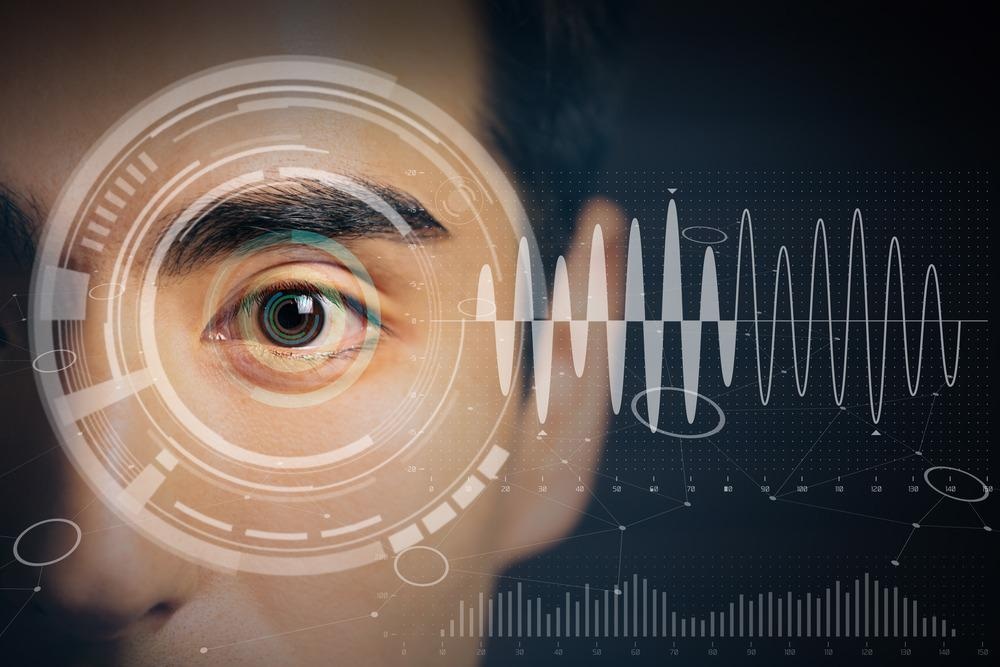
Image Credit: metamorworks/Shutterstock.com
A global team of engineers from the UK, US, and China has developed a breakthrough sensor system and manufacturing process to produce ultra-thin smart contact lenses.
The engineers from the University of Surrey – together with partners from Harvard University, University of Science and Technology of China, UK National Physical Laboratory, George Washington University and Zhejiang University Ningbo Research Institute – say their system can be directly incorporated onto soft contact lenses using an easy assembly method. The final design will provide comfort and biocompatibility, robustness, transparency, and detection sensitivity, which outperforms other smart lenses.
Dr Yunlong Zhao, the study’s corresponding author, said devices such as theirs could be used as a “non-invasive way to help monitor and diagnose people’s health” and that the research could provide “not only a unique and simple method for manufacturing advanced smart contact lenses but also novel insight for designing other multifunctional electronics for human-machine interface.”
Health Monitoring using Smart Contact Lenses
Contact lenses are already one of the world’s most popular wearable medical devices and are used by over 150 million people worldwide for both cosmetic and therapeutic purposes. Because contact lenses interact with both the body’s internal chemistry via tear fluid and external air surrounding the eye, they are well-placed as a platform to analyze physiological and external ambient conditions.
Tear fluid is high in proteins and biomarkers, providing highly accurate and reliable physiological information that outperforms data from the skin, sweat, or wrist-worn wearables and smart patches. This makes contact lenses a prime candidate in the use of wearables for health monitoring.
Clinical trials have clearly demonstrated that tear fluid can effectively measure glucose levels, making smart contact lenses potentially useful in diabetic diagnostics and conditions closely related to blood glucose regulation disorders, such as strokes and heart disease.
Eye-related diseases such as dry eye disease and inflammation could also be diagnosed and treated using sensors that monitor light intensity, blinking, corneal temperature, intraocular pressure, and other variables.
The Breakthrough Smart Lens
The researchers said the use of smart lenses is currently significantly limited by their “mechanical biocompatibility, detection sensitivity, and challenging integration process”. For smart contact lenses to be widely adopted, they need to overcome these limitations. They also need to be comfortable and practical to wear.
The researchers aimed to create soft contact lenses with multifunctional sensor systems that use ultra-thin sensors and components. Unlike traditional rigid or bulk sensors and circuit chips, which are sandwiched in the lens substrate, ultra-thin sensors can be placed directly onto lenses and in direct contact with tear fluid.
Lenses created from ultra-thin components can also be more comfortable to wear, have higher detection sensitivity, and be easier to assemble.
The researchers’ breakthrough design used:
- Ultra-thin (few-to-monolayer) TMDC semiconductors, elastic interconnect electrodes, polyimide (PI) passivation layers, and a polydimethylsiloxane (PDMS) lens substrate.
- Ultra-thin MoS2 transistors, which exhibit high sensitivity for glucose monitoring and are highly responsive, as the core sensing material.
- MoS2 transistors mechanically re-enforced with a thin layer of photo-patternable PI and elastic parts formed using serpentine gold and PI mesh structure.
- A gold-mediated exfoliation and assembly strategy
- An integrated sensor system placed around the cornea’s outer ring to avoid blocking vision, allowing for the collection of optical, glucose and temperature information from the contact lens.
This design allowed for high flexibility while protecting electronics from mechanical deformation. Researchers said the design also met the transparency and biocompatibility requirements for practical and commercial applications.
The smart contact lens developed contains photodetectors to receive optical information, a temperature sensor for diagnosing potential corneal disease, and a glucose sensor for directly monitoring the glucose levels in tear fluid.
Future Developments and Applications
The team says their solution is not only useful for smart lenses but could also be applied to other multifunctional and implantable bioelectronics.
The integrated sensor system and manufacturing method used in the lens also open up the possibility of incorporating additional components such as antennas for wireless communication, biofuel cells and power modules, moisture-based energy harvesting, and wireless radio frequency for live research.
Co-author Professor Sheng Zhang said “personalized and accurate medical analysis” is also possible with the addition of advanced algorithms and “will become one of the major research directions at the Ningbo Research Institute”.
References and Further Reading
Guo et al. (2020) Integrated contact lens sensor system based on multifunctional ultrathin MoS2 transistors. Matter. doi.org/10.1016/j.matt.2020.12.002
R Moreddu; D Vigolo; AK Yetisen (2019) Contact Lens Technology: From fundamentals to Applications. Advanced Healthcare Materials. https://doi.org/10.1002/adhm.201900368.
Eurekalert! (2021) Surrey unveils breakthrough manufacturing process of ultra-thin sensor for smart contact lenses. [Online] Available at: https://www.eurekalert.org/pub_releases/2021-01/uos-sub010621.php (Accessed on 25 January 2021).
Disclaimer: The views expressed here are those of the author expressed in their private capacity and do not necessarily represent the views of AZoM.com Limited T/A AZoNetwork the owner and operator of this website. This disclaimer forms part of the Terms and conditions of use of this website.